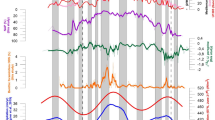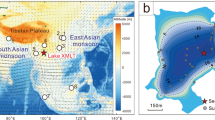Abstract
External climate forcings—such as long-term changes in solar insolation—generate different climate responses in tropical and high latitude regions1. Documenting the spatial and temporal variability of past climates is therefore critical for understanding how such forcings are translated into regional climate variability. In contrast to the data-rich middle and high latitudes, high-quality climate-proxy records from equatorial regions are relatively few2,3,4, especially from regions experiencing the bimodal seasonal rainfall distribution associated with twice-annual passage of the Intertropical Convergence Zone. Here we present a continuous and well-resolved climate-proxy record of hydrological variability during the past 25,000 years from equatorial East Africa. Our results, based on complementary evidence from seismic-reflection stratigraphy and organic biomarker molecules in the sediment record of Lake Challa near Mount Kilimanjaro, reveal that monsoon rainfall in this region varied at half-precessional (∼11,500-year) intervals in phase with orbitally controlled insolation forcing. The southeasterly and northeasterly monsoons that advect moisture from the western Indian Ocean were strengthened in alternation when the inter-hemispheric insolation gradient was at a maximum; dry conditions prevailed when neither monsoon was intensified and modest local March or September insolation weakened the rain season that followed. On sub-millennial timescales, the temporal pattern of hydrological change on the East African Equator bears clear high-northern-latitude signatures, but on the orbital timescale it mainly responded to low-latitude insolation forcing. Predominance of low-latitude climate processes in this monsoon region can be attributed to the low-latitude position of its continental regions of surface air flow convergence, and its relative isolation from the Atlantic Ocean, where prominent meridional overturning circulation more tightly couples low-latitude climate regimes to high-latitude boundary conditions.
This is a preview of subscription content, access via your institution
Access options
Subscribe to this journal
Receive 51 print issues and online access
$199.00 per year
only $3.90 per issue
Buy this article
- Purchase on Springer Link
- Instant access to full article PDF
Prices may be subject to local taxes which are calculated during checkout


Similar content being viewed by others
References
Clement, A. C., Hall, A. & Broccoli, A. J. The importance of precessional signals in the tropical climate. Clim. Dyn. 22, 327–341 (2004)
Partin, J. W., Cobb, K. M., Adkins, J. F., Clark, B. & Fernandez, D. P. Millennial-scale trends in west Pacific warm pool hydrology since the Last Glacial Maximum. Nature 449, 452–455 (2007)
Cruz, F. W. et al. Orbitally driven east-west antiphasing of South American precipitation. Nature Geosci. 2, 210–214 (2009)
Gasse, F., Chalié, F., Vincens, A., Williams, M. A. J. & Williamson, D. Climatic patterns in equatorial and southern Africa from 30,000 to 10,000 years ago reconstructed from terrestrial and near-shore proxy data. Quat. Sci. Rev. 27, 2316–2340 (2008)
Trauth, M. H., Maslin, M. A., Deino, A. & Strecker, M. R. Late Cenozoic moisture history of East Africa. Science 309, 2051–2053 (2005)
Wang, Y. J. et al. Millennial- and orbital-scale changes in the East Asian monsoon over the past 224,000 years. Nature 451, 1090–1093 (2008)
Fleitmann, D. et al. Holocene ITCZ and Indian monsoon dynamics recorded in stalagmites from Oman and Yemen (Socotra). Quat. Sci. Rev. 26, 170–188 (2007)
Vellinga, M. & Wood, R. A. Global climatic impacts of a collapse of the Atlantic thermohaline circulation. Clim. Change 54, 251–267 (2002)
McManus, J. F., Francois, R., Gherardi, J. M., Keigwin, L. D. & Brown-Leger, S. Collapse and rapid resumption of Atlantic meridional circulation linked to deglacial climate changes. Nature 428, 834–837 (2004)
Zhang, R. & Delworth, T. L. Simulated tropical response to a substantial weakening of the Atlantic thermohaline circulation. J. Clim. 18, 1853–1860 (2005)
deMenocal, P. et al. Abrupt onset and termination of the African Humid Period: rapid climate responses to gradual insolation forcing. Quat. Sci. Rev. 19, 347–361 (2000)
Kutzbach, J. E. Monsoon climate of the early Holocene: climate experiment with Earth’s orbital parameters for 9000 years ago. Science 214, 59–61 (1981)
Peterson, L. C., Haug, G. H., Hughen, K. A. & Röhl, U. Rapid changes in the hydrological cycle of the tropical Atlantic during the last glacial. Science 290, 1947–1950 (2000)
Talbot, M. R., Filippi, M. L., Jensen, N. B. & Tiercelin, J.-J. An abrupt change in the African monsoon at the end of the Younger Dryas. Geochem. Geophys. Geosyst. 8 10.1029/2006GC001465 (2007)
Thompson, L. G. et al. Kilimanjaro ice core records: evidence of Holocene climate change in tropical Africa. Science 298, 589–593 (2002)
Tierney, J. E. et al. Northern Hemisphere controls on tropical Southeast African climate during the last 60,000 years. Science 322, 252–255 (2008)
Cruz, F. W. et al. Insolation-driven changes in atmospheric circulation over the past 116,000 years in sub-tropical Brazil. Nature 434, 63–66 (2005)
Haug, G. H., Hughen, K. A., Sigman, D. M., Peterson, L. C. & Rohl, U. Southward migration of the intertropical convergence zone through the Holocene. Science 293, 1304–1308 (2001)
Thevenon, F., Williamson, D. & Taieb, M. A 22-kyr BP sedimentological record of Lake Rukwa (8° S, SW Tanzania): environmental, chronostratigraphic and climatic implications. Palaeogeogr. Palaeoclimatol. Palaeoecol. 187, 285–294 (2002)
Berger, A., Loutre, M. F. & Mélice, J. L. Equatorial insolation: from precession harmonics to eccentricity frequencies. Clim. Past 2, 131–136 (2006)
Peyron, O., Jolly, D., Bonnefille, R., Vincens, A. & Guiot, J. Climate of East Africa 6000 14C yr BP as inferred from pollen data. Quat. Res. 54, 90–101 (2000)
Garcin, Y., Vincens, A., Williamson, D., Guiot, J. & Buchet, G. Wet phases in tropical southern Africa during the last glacial period. Geophys. Res. Lett. 33 L07703 10.1029/2005GL025531 (2006)
Mumbi, C. T., Marchant, R., Hooghiemstra, H. & Wooller, M. J. Late Quaternary vegetation reconstruction from the Eastern Arc Mountains, Tanzania. Quat. Res. 69, 326–341 (2008)
Barker, P. A. et al. A 14,000-year oxygen isotope record from diatom silica in two alpine lakes on Mt. Kenya. Science 292, 2307–2310 (2001)
Verschuren, D. & Charman, D. J. in Natural Climate Variability and Global Warming (eds Battarbee, R. W. & Binney, H. E.) 189–231 (Wiley-Blackwell, 2008)
Pinot, S. et al. Tropical paleoclimates at the Last Glacial Maximum: comparison of Paleoclimate Modeling Intercomparison Project (PMIP) simulations and paleodata. Clim. Dyn. 15, 857–874 (1999)
Ruddiman, W. F. What is the timing of orbital-scale monsoon changes? Quat. Sci. Rev. 25, 657–658 (2006)
EPICA community members One-to-one coupling of glacial climate variability in Greenland and Antarctica. Nature 444, 195–198 (2006)
Rasmussen, S. O. et al. A new Greenland ice core chronology for the last glacial termination. J. Geophys. Res. 111 10.1029/2005JD006079 (2006)
Berger, A. & Loutre, M.-F. Insolation values for the climate of the last 10 million years. Quat. Sci. Rev. 10, 297–317 (1991)
Acknowledgements
This research was sponsored by funding agencies in Belgium (FWO-Vlaanderen), Denmark (Danish National Research Council), Germany (DFG) and The Netherlands (NWO) through the European Science Foundation (ESF) EuroCORES programme, EuroCLIMATE. Fieldwork was conducted with permission of the Kenyan Ministry of Education, Science and Technology (MOEST) and the Tanzania Commission for Science and Technology (COSTECH). We thank A. Alcantara, M. Kohler, S. Lauterbach, R. Niederreiter and S. Opitz for assistance with core collection and processing; D. Engstrom for 210Pb dating, A. Berger, D. Fleitmann, J. Kutzbach and Z. Liu for discussion, and E. Odada for support. J.M. acknowledges the support of the Institute for the Promotion of Innovation through Science and Technology in Flanders (IWT-Vlaanderen).
Author Contributions D.V. initiated and coordinated the research, and wrote the paper. J.S.S.D. was responsible for the production of the biomarker data, J.M. interpreted the seismic-reflection data, I.K. constructed the composite sediment sequence and depth scale, M.B. developed the sediment age model, and M.F. supervised core sampling and managed the project database. G.H.H. and all CHALLACEA members contributed their expertise to improving the discussed data sets and/or the manuscript.
Author information
Authors and Affiliations
Consortia
Corresponding author
Additional information
Lists of participants and affiliations appear at the end of the paper.
Supplementary information
Supplementary Information
This file contains Supplementary Methods, Supplementary Discussions, Supplementary Figures 1-7 with Legends and Supplementary References. (PDF 1450 kb)
PowerPoint slides
Rights and permissions
About this article
Cite this article
Verschuren, D., Sinninghe Damsté, J., Moernaut, J. et al. Half-precessional dynamics of monsoon rainfall near the East African Equator . Nature 462, 637–641 (2009). https://doi.org/10.1038/nature08520
Received:
Accepted:
Issue Date:
DOI: https://doi.org/10.1038/nature08520
This article is cited by
-
Reversed Holocene temperature–moisture relationship in the Horn of Africa
Nature (2023)
-
A Jurassic record encodes an analogous Dansgaard–Oeschger climate periodicity
Scientific Reports (2022)
-
Orbital controls on eastern African hydroclimate in the Pleistocene
Scientific Reports (2022)
-
Tropical forcing orbital-scale precipitation variations revealed by a maar lake record in South China
Climate Dynamics (2022)
-
Inter-hemispheric synchroneity of Holocene precipitation anomalies controlled by Earth’s latitudinal insolation gradients
Nature Communications (2020)
Comments
By submitting a comment you agree to abide by our Terms and Community Guidelines. If you find something abusive or that does not comply with our terms or guidelines please flag it as inappropriate.



